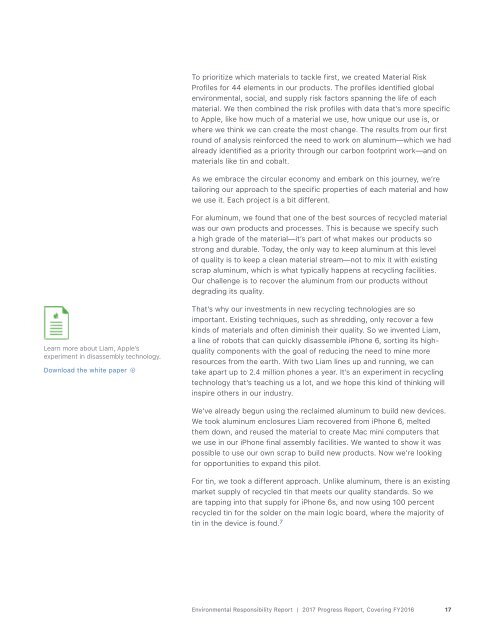Apple Environmental Responsibility Report
Create successful ePaper yourself
Turn your PDF publications into a flip-book with our unique Google optimized e-Paper software.
To prioritize which materials to tackle first, we created Material Risk<br />
Profiles for 44 elements in our products. The profiles identified global<br />
environmental, social, and supply risk factors spanning the life of each<br />
material. We then combined the risk profiles with data that’s more specific<br />
to <strong>Apple</strong>, like how much of a material we use, how unique our use is, or<br />
where we think we can create the most change. The results from our first<br />
round of analysis reinforced the need to work on aluminum—which we had<br />
already identified as a priority through our carbon footprint work—and on<br />
materials like tin and cobalt.<br />
As we embrace the circular economy and embark on this journey, we’re<br />
tailoring our approach to the specific properties of each material and how<br />
we use it. Each project is a bit different.<br />
For aluminum, we found that one of the best sources of recycled material<br />
was our own products and processes. This is because we specify such<br />
a high grade of the material—it’s part of what makes our products so<br />
strong and durable. Today, the only way to keep aluminum at this level<br />
of quality is to keep a clean material stream—not to mix it with existing<br />
scrap aluminum, which is what typically happens at recycling facilities.<br />
Our challenge is to recover the aluminum from our products without<br />
degrading its quality.<br />
Learn more about Liam, <strong>Apple</strong>’s<br />
experiment in disassembly technology.<br />
Download the white paper ↓ ⃝<br />
That’s why our investments in new recycling technologies are so<br />
important. Existing techniques, such as shredding, only recover a few<br />
kinds of materials and often diminish their quality. So we invented Liam,<br />
a line of robots that can quickly disassemble iPhone 6, sorting its highquality<br />
components with the goal of reducing the need to mine more<br />
resources from the earth. With two Liam lines up and running, we can<br />
take apart up to 2.4 million phones a year. It’s an experiment in recycling<br />
technology that’s teaching us a lot, and we hope this kind of thinking will<br />
inspire others in our industry.<br />
We’ve already begun using the reclaimed aluminum to build new devices.<br />
We took aluminum enclosures Liam recovered from iPhone 6, melted<br />
them down, and reused the material to create Mac mini computers that<br />
we use in our iPhone final assembly facilities. We wanted to show it was<br />
possible to use our own scrap to build new products. Now we’re looking<br />
for opportunities to expand this pilot.<br />
For tin, we took a different approach. Unlike aluminum, there is an existing<br />
market supply of recycled tin that meets our quality standards. So we<br />
are tapping into that supply for iPhone 6s, and now using 100 percent<br />
recycled tin for the solder on the main logic board, where the majority of<br />
tin in the device is found. 7<br />
<strong>Environmental</strong> <strong>Responsibility</strong> <strong>Report</strong> | 2017 Progress <strong>Report</strong>, Covering FY2016<br />
17







